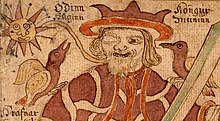Huginn e Muninn

Huginn e Muninn sono due corvi presenti nella mitologia norrena, associati al dio Odino. Huginn e Muninn viaggiano per il mondo portando notizie e informazioni al loro padrone. Odino li fa uscire all'alba per raccogliere informazioni e ritornano alla sera, siedono sulle spalle del dio e gli sussurrano le notizie nelle orecchie. È da questi corvi che deriva il kenning dio-corvo che rappresenta Odino.
Entrambi i nomi dei corvi derivano dal norreno, Huginn significa pensiero mentre Muninn memoria.
Così è detto nel poema eddico Grímnismál, al XX canto:
«Huginn ok Muninn
fliúga hverian dag
iörmungrund yfir;
óumk ek of Hugin
at hann aptr ne komit,
þó siámk meirr um Munin.»
«Huginn e Muninn
volano ogni giorno
alti intorno alla terra.
Io ho timore per Huginn
che non ritorni;
ma ho ancora più timore per Muninn.»
(Edda poetica - Grímnismál - Il discorso di Grímnir XX)
Bibliografia
- Bellows, Henry Adams (1923). The Poetic Edda. American-Scandinavian Foundation.
- Bernd, Heinrich (2006 [1999]). The Mind of the Raven. Harper Perennial. ISBN 978-0-06-113605-4
- Faulkes, Anthony (Trans.) (1995). Edda. Everyman. ISBN 0-460-87616-3
- Hollander, Lee Milton. (Trans.) (2007). Heimskringla: History of the Kings of Norway. University of Texas Press. ISBN 978-0-292-73061-8
- Ingstad, Anne Stine (1995). "The Interpretation of the Oseberg-find" as published in Crumlin-Pedersen, Ole and Thye, Birgitte Munch (Editors). The Ship as Symbol in Prehistoric and Medieval Scandinavia: Papers from an International Research Seminar at the Danish National Museum, Copenhagen, 5–7 May 1994. Nationalmuseet. ISBN 87-89384-01-6
- Jansson, Sven B. (1987). Runes in Sweden. Stockholm, Gidlund. ISBN 91-7844-067-X
- Jensen, Stig (1990). "Odin from Ribe" as collected in Oldtidens Ansigt: Faces of the Past. Det kongelige Nordiske Oldskriftselskab. ISBN 87-7468-274-1
- Lindow, John (2001). Norse Mythology: A Guide to the Gods, Heroes, Rituals, and Beliefs. Oxford University Press. ISBN 0-19-515382-0
- Murphy, G. Ronald. 1989. The Saxon Savior. Oxford University Press. ISBN 0-19-506042-3
- Orchard, Andy (1997). Dictionary of Norse Myth and Legend. Cassell. ISBN 0-304-34520-2
- Petersen, Peter Vang (1990). "Odin's Ravens" as collected in Oldtidens Ansigt: Faces of the Past. Det kongelige Nordiske Oldskriftselskab. ISBN 87-7468-274-1
- Aleks Pluskowski, Apocalyptic Monsters: Animal Inspirations for the Iconography of Medieval Northern Devourers, in Bettina Bildhauer e Robert Mills (a cura di), The Monstrous Middle Ages, University of Toronto Press, 2004, ISBN 0-8020-8667-5.
- Rundata 2.0 for Windows.
- Simek, Rudolf (2007) translated by Angela Hall. Dictionary of Northern Mythology. D.S. Brewer. ISBN 0-85991-513-1
- Thorpe, Benjamin (Trans) (1907). Edda Sæmundar Hinns Frôða The Edda of Sæmund the Learned. Part I. London Trübner & Co
- Wills, Tarrin (2006). "The Anonymous Verse in the Third Grammatical Treatise" As published in McKinnell, John, Ashurst, David. Donata, Kick. (Editors). The Fantastic in Old Norse/Icelandic Literature, Sagas, and the British Isles: Preprint Papers of The 13th International Saga Conference Durham and York, 6–12 August 2006. Durham : The Centre for Medieval and Renaissance Studies. Online.
- Anthony Winterbourne, When the Norns Have Spoken: Time and Fate in Germanic Paganism, Rosemont Publishing & Printing Corp., 2004, ISBN 0-8386-4048-6.
Voci correlate
- Stendardo del corvo
- Valravn, creatura della mitologia norrena
- Helhest, cavallo a tre zampe della mitologia norrena
Altri progetti
Altri progetti
- Wikimedia Commons
 Wikimedia Commons contiene immagini o altri file su Huginn e Muninn
Wikimedia Commons contiene immagini o altri file su Huginn e Muninn
 Portale Mitologia: accedi alle voci di Wikipedia che trattano di Mitologia
Portale Mitologia: accedi alle voci di Wikipedia che trattano di Mitologia













